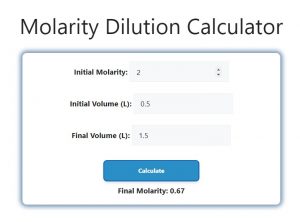About Molarity Dilution Calculator (Formula)
The Molarity Dilution Calculator is a vital tool for chemists, students, and anyone involved in laboratory work who needs to determine the final concentration of a solution after dilution. Dilution is a common procedure in chemistry that involves adding solvent to a solution to decrease its concentration. This calculator simplifies the process, allowing users to input initial conditions and calculate the final molarity of a solution quickly.
Formula
The formula for calculating final molarity during dilution is: Final Molarity = (Initial Molarity * Initial Volume) / Final Volume.
How to Use
Using the Molarity Dilution Calculator is straightforward. Follow these steps:
- Identify Initial Molarity: Determine the concentration of your initial solution in moles per liter (M).
- Measure Initial Volume: Record the volume of the initial solution you have in liters (L).
- Determine Final Volume: Decide the total volume of the solution after dilution, which includes the initial solution and the added solvent.
- Input the Values: Enter the values for initial molarity, initial volume, and final volume into the calculator.
- Calculate the Final Molarity: Click the “Calculate” button to determine the final molarity of the diluted solution.
Example
Let’s walk through an example using the Molarity Dilution Calculator:
- Initial Molarity: Suppose you have a solution with an initial molarity of 2.0 M.
- Initial Volume: You start with 0.5 L of this solution.
- Final Volume: You dilute this solution to a final volume of 1.5 L.
- Apply the Formula:
Final Molarity = (2.0 M * 0.5 L) / 1.5 L
Final Molarity = 1.0 / 1.5
Final Molarity = 0.67 M
Thus, the final molarity of the diluted solution is 0.67 M.

FAQs
- What is molarity?
Molarity is a measure of concentration, defined as the number of moles of solute per liter of solution. - What does the Molarity Dilution Calculator do?
It calculates the final molarity of a solution after dilution based on initial conditions. - Can I use the calculator for any type of solution?
Yes, the calculator is applicable to any solution, provided you know the initial conditions. - How do I find the initial molarity?
The initial molarity can be found on the solution’s label or by calculating it from the amount of solute and volume. - What is the difference between initial and final volume?
The initial volume is the amount of solution before dilution, while the final volume is the total volume after adding solvent. - Can this calculator be used for concentrations other than molarity?
The calculator is specifically designed for molarity; however, similar principles apply to other concentration measures. - What if I do not know the final volume?
You must determine the final volume to use the calculator effectively; otherwise, you cannot calculate final molarity. - Is the calculator accurate for very dilute solutions?
Yes, the calculator provides accurate results for both dilute and concentrated solutions. - What units should I use for volume?
The calculator requires volume in liters (L) for consistency. - How does temperature affect molarity?
Temperature can affect the density of the solution and, consequently, the molarity, so it’s essential to conduct measurements at a consistent temperature. - Can I input volumes in milliliters?
While the calculator is designed for liters, you can convert milliliters to liters by dividing by 1000. - What if I want to dilute to a specific molarity?
You can rearrange the formula to determine the volume of solvent needed for the desired final molarity. - Can this calculator be used for mixtures?
Yes, it can be used for any mixture where you can determine initial conditions. - Is there a limit to the concentration values I can enter?
Most calculators do not impose limits, but practical limits based on solubility may apply. - Can I use this calculator for acids and bases?
Yes, the principles apply to all solutions, including acids and bases. - What should I do if I make an error while entering values?
Simply clear the inputs and re-enter the correct values before calculating again. - Is this calculator available as an app?
Many online calculators have mobile versions or apps for convenience. - What should I do if the calculator does not give a result?
Check your inputs for errors, ensure all fields are filled correctly, and try again. - Can I use the calculator for preparation of solutions in lab experiments?
Yes, it’s an excellent tool for preparing solutions accurately in laboratory settings. - What if my dilution involves multiple solutes?
The calculator is designed for one solute at a time; calculate each separately if there are multiple solutes.
Conclusion
The Molarity Dilution Calculator is a valuable tool for anyone working with chemical solutions, making the process of dilution easy and efficient. By understanding how to use this calculator and the formula behind it, users can achieve precise results in their experiments and daily tasks. Whether you’re a student, teacher, or professional chemist, this tool will help you make accurate dilutions, ensuring that your solutions are correctly prepared for any application.